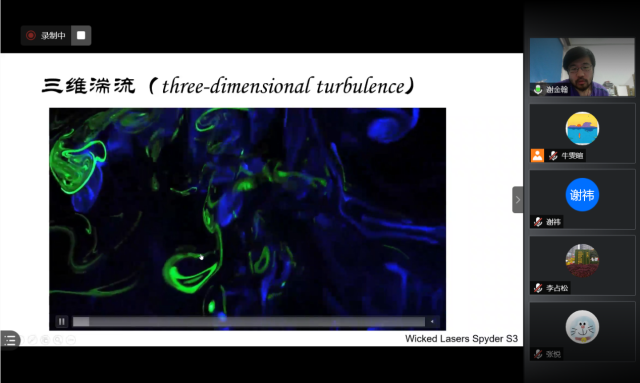Latest News
-
[2020-09-22]
State Key Laboratory for Turbulence and Complex Systems holds online science lectures for the public
Recently, the State Key Laboratory for Turbulence and Complex Systems (LTCS) held a session of four online science lectures for the public. This event is an active response to the Ministry of Science and Technology’s latest call for holding open day on the National Science and Technology Week.
The four online lectures featured four academics- Prof. Weidong Su, Yantao Yang, Shengkai Wang, and Jinhan Xie. More than 300 students at levels varying from middle school to college participated in the event, which was presided over by Professor Yue Yang, deputy director of LTCS.
In the first lecture, Associate Prof. Weidong Su cited pictures and depictions in artworks in Chinese and overseas, ancient and modern, to explain “turbulence” - a classic scientific problem.
He then summarized the main characteristics and physical nature of turbulence, its advantages and disadvantages in application, research methods and difficulties, physical concepts and laws, and discussed the scientific significance of turbulence research.

Prof. Weidong Su gives an online lecture
In the second lecture, Assistant Professor Yantao Yang explained what “buoyancy driven turbulence” is. He said that the change in temperature and concentration is one of the most common causes of uneven density. Under the action of buoyancy, the fluid with uneven density will move, and turbulence will be generated when the temperature change is large enough and the buoyancy driving force is strong enough.
Yang added that buoyancy driven turbulence exists extensively in the atmosphere, oceans, the interior of the earth, industry and life, before describing the conditions of buoyancy-driven turbulence and its main research areas.

Assistant Prof. Yantao Yang talks on “buoyancy driven turbulence”
In the third talk, Assistant Prof. Shengkai Wang discussed a small problem in daily life related to turbulence, namely fluid mechanics in sneezing. He introduced some wonderful optical measurement techniques in contemporary fluid mechanics research. He showed an animation of people sneezing without wearing a mask and wearing a mask, showing the audience the different fluid movement under the optical measurement of the flow field.
Wang also elaborated on the application of cutting-edge optical flow field measurement methods in a wide range of areas, such as human breathing detection, atmospheric environment monitoring and remote sensing, industrial process control, as well as high-speed wind tunnel ground testing and space exploration.

Assistant Professor Shengkai Wang gives an online report
Finally, Assistant Professor Jinhan Xie focused on the cross-scale transmission of energy in his talk about the multi-scale flow structure in complex atmospheric turbulence.
He first briefly described the phenomenon that large-scale vortices break into small-scale vortices in three-dimensional and two-dimensional turbulent flows, and small-scale vortices converge into large-scale vortices, accompanied by cross-scale energy transmission. Using simple to complex, qualitative to quantitative research methods, it is discovered that energy is propagated in both directions to large and small scales in atmospheric turbulence. Finally, Xie took Van Gogh's painting "Starry Sky" as an example to explain how to understand the problems around us from the perspective of turbulence.

Assistant Professor Jinhan Xie talks on cross-scale transmission of energy
During the event, the participants had a lively exchange and discussion with the speakers.
LTCS wishes to continue to participate in the nation’s strategy of “innovation driving progress” and contribute to the national cause of science and technology promotion in the future.
